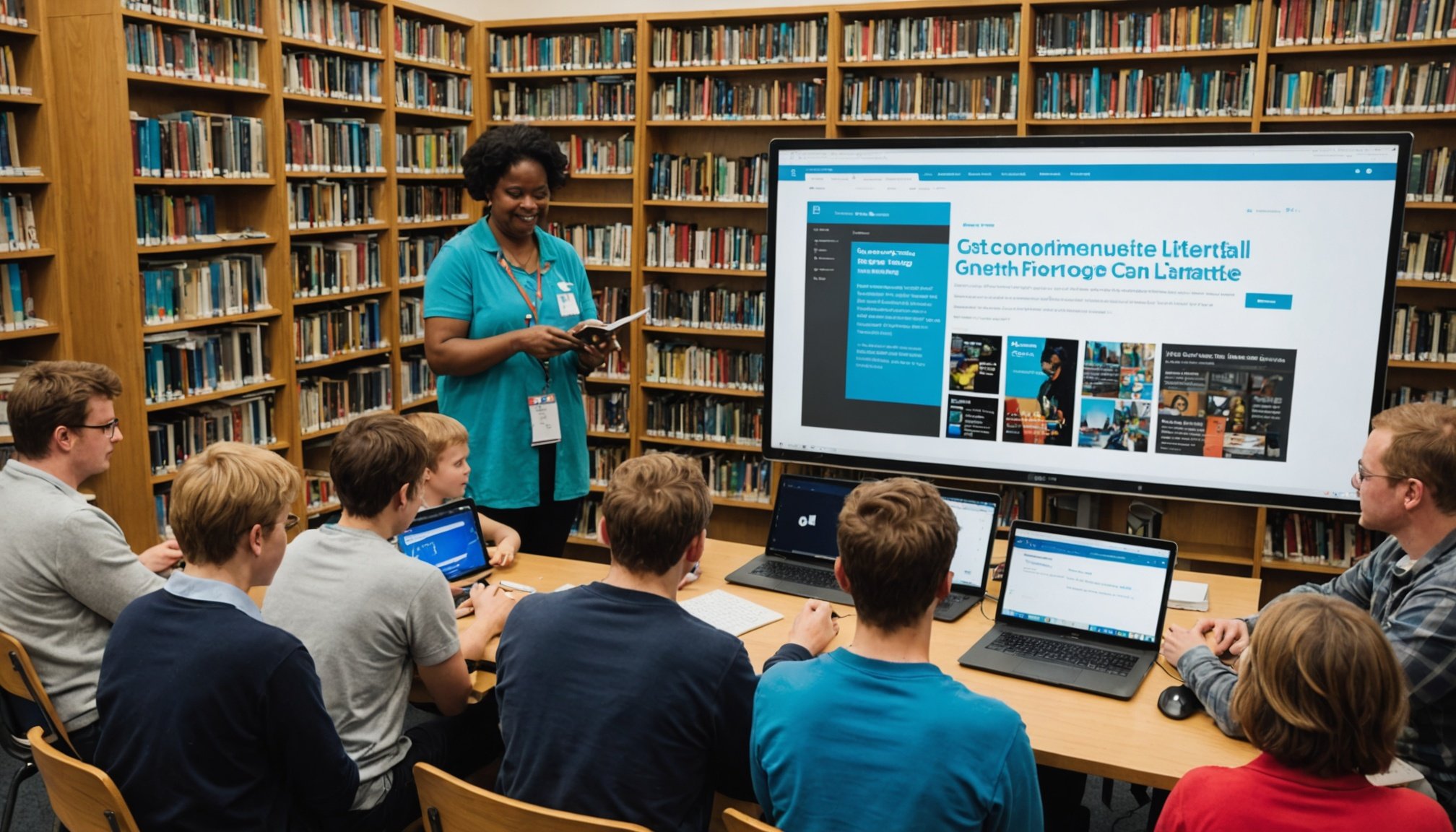Overview of Digital Literacy in Libraries
Digital literacy is a crucial skill in today’s libraries, enhancing community engagement and empowerment. In the UK, libraries are pivotal in fostering these abilities, guiding communities towards understanding and effectively using digital tools. This integration of technology into everyday life through library initiatives supports individuals in navigating the digital world efficiently.
Libraries serve as hubs for digital literacy, establishing platforms for learning and innovation. They offer resources and workshops, equipping visitors with essential skills such as internet navigation, digital communication, and understanding data privacy. These programs are tailored to meet community needs, ensuring accessibility for diverse audiences. By doing so, libraries contribute significantly to reducing the digital divide.
In parallel : Unlocking success: the ultimate compliance handbook for uk online advertising standards
However, promoting digital literacy is not without challenges. Resource limitations, such as funding and staffing in UK libraries, can hinder the development of comprehensive programs. Additionally, addressing varying levels of tech-savviness among community members requires customized approaches, demanding additional resources and strategic planning. Despite these obstacles, libraries continue to explore creative solutions to improve digital literacy initiatives, recognizing their critical role in empowering individuals and promoting informed digital citizenship. Through community engagement and continuous program enhancement, libraries strive to meet these challenges, ensuring everyone can benefit from digital advancements.
Effective Strategies for Implementing Digital Literacy Programs
Establishing a successful digital literacy program requires a nuanced approach to ensure both effectiveness and impact. The first step is to assess the needs of the community. Understanding these specific needs allows for the development of a tailored program that addresses challenges efficiently. For instance, if a community is facing barriers to accessing technology, the program should incorporate solutions to improve access and usability.
Additional reading : Unlocking potential: innovative tactics for uk tourism boards to harness the power of social media influencers
Collaboration is another vital strategy in program implementation. By partnering with local organizations and stakeholders, resources can be shared efficiently, reducing costs and enhancing program reach. Collaboration might include access to teaching facilities, resources, or expertise that can be pivotal in overcoming implementation hurdles.
Engaging a variety of teaching methods is crucial to cater to different learning styles and levels. While some participants might thrive with hands-on workshops, others might prefer online modules or group discussions. Incorporating diverse methods enriches the learning experience and boosts overall engagement.
By addressing community needs, leveraging collaborative efforts, and diversifying teaching methods, digital literacy programs can be implemented with greater success, substantially enriching the digital skills of participants.
Case Studies: Successful Digital Literacy Initiatives in the UK
Exploring successful digital literacy initiatives in the UK reveals insightful case studies where strategic approaches turned ambitions into reality.
Overview of Selected Case Studies
Examples of successful programs include library initiatives across the UK which have effectively improved digital literacy. Many libraries have implemented targeted workshops tailored to diverse user groups from children to seniors, enhancing their technological skills.
Key Factors in Successful Implementation
Successful programs often share several key factors contributing to their effectiveness: stakeholder engagement, comprehensive support systems, and flexibility. Libraries have engaged community leaders and local businesses to broaden expertise and extend resource outreach. Moreover, offering comprehensive support—like individual tutoring sessions—ensures all participants can succeed individually and collectively. Crucially, flexibility in program structure enables libraries to tailor experiences to their community‘s specific needs.
Lessons Learned and Best Practices
Drawing lessons from successful programs can guide other libraries aiming to launch or refine initiatives. Libraries should prioritise including their users in planning phases, ensuring the relevance of their services. Broadening access by removing barriers, such as financial constraints, and continuously evaluating program impact ensures long-term sustainability. Adopting these best practices can enhance digital literacy across diverse communities, empowering individuals through technology.
Resources for Training Library Staff on Digital Literacy
Enhancing digital literacy among library staff is vital for providing modern library services. Staff training can effectively be achieved through specialized training programs and workshops. These programs are designed to keep library personnel updated on the ever-evolving world of digital information. A variety of options are available, including in-person workshops that offer hands-on experience and networking opportunities with peers.
In addition to workshops, professional development can be supported through online platforms which offer digital literacy resources. Platforms such as Coursera, LinkedIn Learning, and edX provide a wealth of educational content tailored for library staff. These platforms incorporate video tutorials, interactive modules, and assessments to ensure a comprehensive understanding of the subjects.
Fostering a growth mindset among library personnel is fundamental. Encouraging staff to embrace new technologies and learn continuously enhances their ability to serve patrons effectively. This mindset not only improves their personal skills but also contributes to the library’s reputation as a contemporary hub of information.
By utilizing a combination of workshops, online resources, and a growth-oriented attitude, libraries can ensure their staff remains adept in digital literacy, ultimately leading to improved service delivery and patron satisfaction.
Engaging the Community Through Digital Literacy Initiatives
Empowering an entire community through digital literacy requires strategic engagement and inclusive outreach. With tailored initiatives, everyone can gain the skills needed in today’s digital world.
Creating Inclusive Programs
Developing inclusive programs is vital for effective community engagement. The aim is to design activities and materials that consider diverse backgrounds, skill levels, and accessibility needs. Techniques like interactive workshops and online tutorials can cater to different learners. It is essential to address barriers such as language and technology access, ensuring everyone can benefit from digital learning. Engaging individuals through feedback can further refine these initiatives, making them more relevant and practical for the community.
Leveraging Social Media for Outreach
Social media platforms have become powerful allies in community outreach. They provide an accessible space for promoting digital literacy events and fostering digital inclusion. By sharing impactful stories, testimonials, and educational content, you can reach a broader audience. Consistent and creative campaigns can drive home the importance of digital skills, while interactive posts and live stream events invite active participation, ensuring a lively engagement.
Building Partnerships with Local Organizations
Collaboration with local organizations amplifies the impact of digital literacy efforts. Partnering with businesses, schools, and nonprofits can enhance resource reach and distribution. These alliances bring diverse expertise, facilitating comprehensive support for the community. Joint ventures can also offer incentives such as workshops, scholarships, or internships, fostering a supportive environment for lifelong learning.
Measuring the Impact of Digital Literacy Programs
Understanding the effectiveness of digital literacy programs is vital. Employing robust program evaluation is essential for determining their actual influence. The first step often involves identifying measurable outcomes, such as improved technical skills, increased internet usage, or enhanced job prospects. Metrics like these can offer a concrete picture of success.
Impact assessment goes further. It delves into the deeper effects of digital literacy initiatives on individuals and communities. Beyond quantifying changes, it explores how these programs transform lives, fostering empowerment and independence.
Feedback from participants plays a crucial role. Input and experiences shared by attendees provide invaluable insights for refining future efforts. Listening carefully to participant narratives can identify areas needing adjustment, ensuring continuous improvement.
To sustain engagement and growth, developing long-term strategies is imperative. These strategies might include continuous content updates, integrating feedback loops, and building community partnerships. Such efforts help maintain participant interest and foster continuous learning environments.
In summary, the diligent assessment of digital literacy programs, informed by key metrics and participant feedback, can shape robust frameworks. These frameworks sustain impact, nurture growth, and enhance the overall effectiveness of literacy initiatives.











